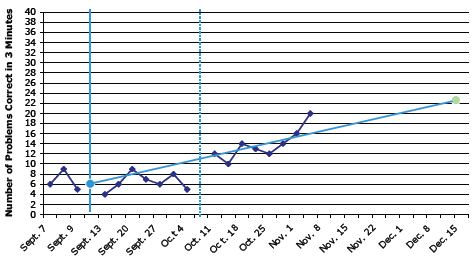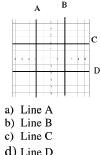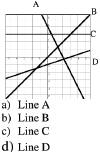Algebra Progress Monitoring
Session Overview
 Introductions
Introductions
 Project AAIMS
Project AAIMS
 Progress monitoring (PM)
Progress monitoring (PM)
 Using PM data
Using PM data
 Discussion
Discussion
Introductions
 Who am I?
Who am I?
• Project AAIMS Project Coordinator
• Former teacher
 Who are you?
Who are you?
• Middle school/high school; general/special
education; classroom teacher/other role
Project AAIMS
 Federally-funded 3 year research grant
Federally-funded 3 year research grant
 U.S. Department of Education, Office of
U.S. Department of Education, Office of
Special Education Programs
 Two primary activities
Two primary activities
1. Describe algebra instruction for students with
and without disabilities (in both general and
special education settings); examine alignment
across settings
2. Develop and validate screening/progress
monitoring assessment tools for beginning
algebra classes
Project AAIMS Partner Districts
 Ballard Junior/Senior High School
Ballard Junior/Senior High School
• Huxley, IA
 Fort Dodge Senior High School
Fort Dodge Senior High School
• Fort Dodge, IA
 South Tama County Senior High School
South Tama County Senior High School
• Tama, IA
Project AAIMS Research Plan
 Series of studies to develop and
Series of studies to develop and
validate algebra progress monitoring
measures
• Static measures of performance
• ‘snapshot’
• Measures of student growth over time
• ‘movie’
• Utility of measures for teacher decision
making
Origins of Progress Monitoring
 Special Education – 30 year history
Special Education – 30 year history
 Elementary
Elementary
• Reading (DIBELS)
• Math
 Secondary
Secondary
• Project AAIMS
 AYP Requirements (NCLB)
AYP Requirements (NCLB)
Progress Monitoring
 Formative evaluation
Formative evaluation
 Long- term measurement
Long- term measurement
 Objective data to inform instructional
Objective data to inform instructional
decision making
 Graphed data to facilitate visual
Graphed data to facilitate visual
interpretation
 Repeated measurement using equivalent
Repeated measurement using equivalent
brief tasks and standard conditions
Mary's Math Progress

Characteristics of
Progress Monitoring Measures
 Brief (5 to 7 minutes); consistent timing
Brief (5 to 7 minutes); consistent timing
 Repeatable; constant difficulty
Repeatable; constant difficulty
 Easy to administer and score
Easy to administer and score
 Associated with other indicators of proficiency
Associated with other indicators of proficiency
(teacher ratings, grades, standardized test
scores)
 Sensitive to changes in student performance
Sensitive to changes in student performance
over time
5 Measures
 Basic Skills
Basic Skills
 Algebra Foundations
Algebra Foundations
 Content Analysis
Content Analysis
(constructed response)
 Translations
Translations
 Content Analysis-Multiple
Content Analysis-Multiple
Choice
Basic Skills
| Solve: 9 + a = 15 a = |
Solve: 10 – 6 = g g = |
| Evaluate: 12 + (– 8) + 3 |
Simplify : 9 – 4d + 2 + 7d |
| Simplify: 2x + 4 + 3x + 5 |
Simplify: 5(b – 3) – b |
| Solve: 12 – e = 4 e = |
Solve: q • 5 = 30 q = |
| Simplify: 4(3 + s) – 7 |
Evaluate: 8 – (– 6) – 4 |
| Simplify: b + b + 2b |
Simplify: 2 + w(w – 5) |
| Solve: b/6 = 12/18 b = |
Solve: 1 foot =12 inches 5 feet = ____ inches |
| Simplify: 7 – 3(f – 2) |
Simplify: 4 – 7b + 5(b – 1) |
| Evaluate: – 5 + (– 4) – 1 |
Simplify: s + 2s – 4s |
| Solve: 63 ÷ c = 9 c = |
Solve: x + 4 = 7 x = |
| Simplify: 2(s – 1) + 4 + 5s |
Simplify: – 5(q + 3) + 9 |
| Simplify: 8m – 9(m + 2) |
Evaluate: 9 + (– 3) – 8 |
Form A: Basic Skills
(in Algebra)
 60 items; 5 minutes
60 items; 5 minutes
 Problems include solving simple (fact)
Problems include solving simple (fact)
equations; combining like terms ; simplifying
expressions ; proportional reasoning
 Hypothesis: these types of tasks may serve a
Hypothesis: these types of tasks may serve a
function in algebra that parallels the role of
decoding in reading comprehension: an
enabling skill that is necessary, but not
sufficient, to support more complex skills
 Scoring: # of problems correct
Scoring: # of problems correct
Content Analysis - Multiple Choice
| Evaluate b2-a2 when a = 4 and b = 5 a)21 |
Rewrite this expression without parenthese : (-5)(4 - y)
|
Sole: 2t - 5 = 7
|
Sole: y/3 = 4
|
| Which line on the graph is y = 2?
|
Which line on the graph is y + 2x = 4?
|
Write the equation in slope - interept form: 
|
Rewrite this equation in standard form using jnteger coefficients . 
|
Content Analysis-Multiple Choice
 16 items; 7 minutes
16 items; 7 minutes
 Problems are sampled from 2 core concepts
Problems are sampled from 2 core concepts
from the first 8 chapters of text
 Multiple choice
Multiple choice
 Scoring: 3 points per problem, -1 pt. penalty for
Scoring: 3 points per problem, -1 pt. penalty for
guessing; partial credit awarded for work shown
| Prev | Next |






